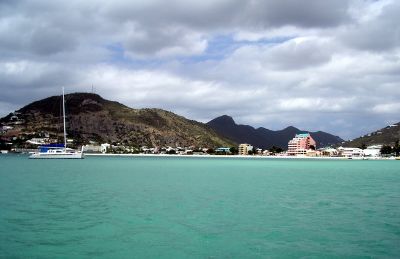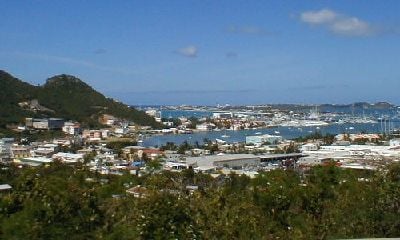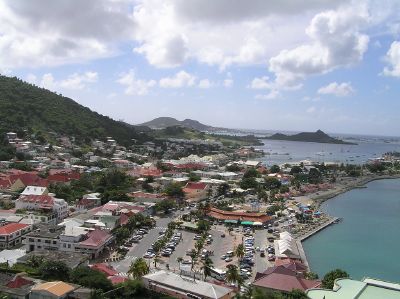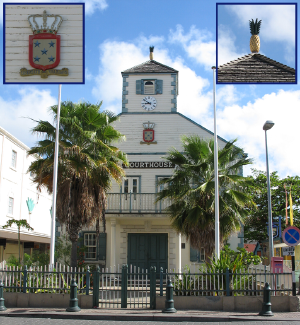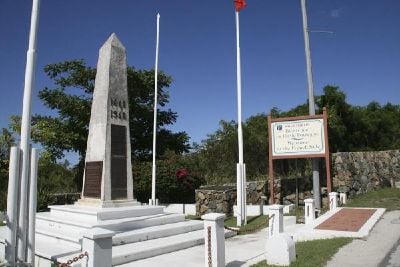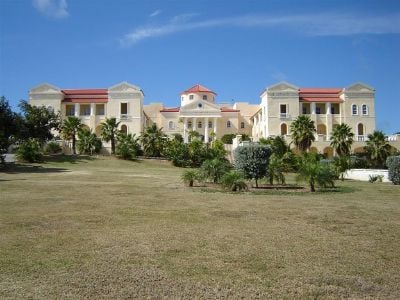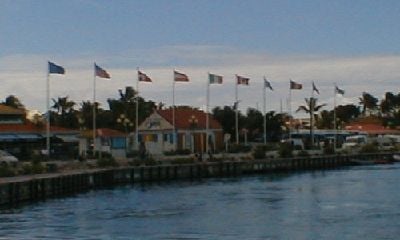Saint Martin
| Native name: Sint Maarten (Dutch) Saint-Martin (French) Sobriquet: The Friendly Island | |
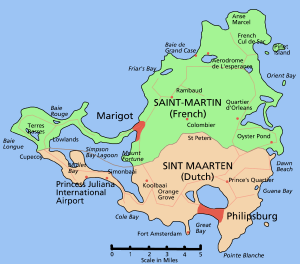
| |
| Geography | |
|---|---|
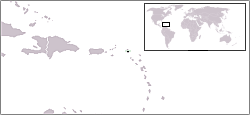 | |
| Location | Caribbean Sea |
| Coordinates | |
| Archipelago | Leeward Islands, Lesser Antilles |
| Area | 87 km² (34 sq mi) |
| Highest point | Pic Paradis (414 m (1,360 ft)) |
| Sovereignty | |
| Overseas collectivity | |
| Capital city | Marigot |
| Largest city | Marigot (5,700) |
| Constituent country | |
| Capital city | Philipsburg |
| Largest city | Lower Prince's Quarter (8,123) |
| Demographics | |
| Population | 73,666[1] [2] (as of Jan. 2019) |
Saint Martin is a tropical island in the northeast Caribbean, approximately 186 miles (300 km) east of Puerto Rico. The island is divided into two parts, between the French Republic and the Kingdom of the Netherlands; it is the smallest inhabited territory divided between two nations. The northern French part comprises the Collectivity of Saint Martin and is an overseas collectivity of the French Republic. As part of France, the French part of the island is also part of the European Union. The southern Dutch part comprises Sint Maarten and is one of four constituent countries that form the Kingdom of the Netherlands. Together, the two territories are known as "Saint-Martin/Sint Maarten."
The differences between the two sides are more cultural and linguistic than political, with unrestricted border crossings. Although only a marker divides the two parts, each retains its own distinct flavor, with the French side reflecting quiet elegance and the Dutch half more casual, including casinos and shopping malls. Both sides rely heavily on tourists to sustain their economy, and both offer duty-free shopping. Tourism accounts for 85 percent of the island's economy.
Though its history is one of conflict between European nations seeking dominance, Saint-Martin today is a multiracial, multicultural society that, although governed by different nations, has been able to put aside the differences that have torn other nations apart.
Geography
Saint Martin has a land area of 37 square miles (96 km²), approximately 20 square miles (52 km²) of which is under the sovereignty of France and 17 square miles (44 km²) under the sovereignty of the Netherlands. There is no physical border between the French and Dutch sides.[3] The island is more than one-third the size of Washington, DC.
The main towns are Philipsburg (Dutch side) and Marigot (French side).
The highest hilltop is Paradise Peak (Pic Paradis) (424 m) at the center of a chain of hills on the French side. There is no river on the island. Hiking trails give access to the dry forest covering the tops and slopes of the hillsides. The lowest point is at the coast.
Salt is the major natural resource. Fresh water supply is dependent on desalinization of sea water.
Physically, the west end is an atoll surrounding a lagoon, while the east end is a range of conical hills. The island has numerous bays, rocky shores, and white sandy beaches.
Climate
The temperature averages 80-85°F all year long. In general, the climate is characterized by low humidity, gentle trade winds, and brief, intense rain showers; July to November is the hurricane season. The total average yearly rainfall is 995 mm, with 99 days of thunder. In September 1960, Hurricane Donna badly hit the island, causing extensive damage. Thirty-five years later, Hurricane Luis again devastated the island.
Flora and fauna
Saint-Martin offers shelter for more than 95 bird species, some indigenous while others are migratory. Among the indigenous, some are vagrants from surrounding islands; others are more permanent residents, including Audubon's shearwater and brown pelicans.
The St. Maarten Marine Park surrounds the entire Dutch side, from Oyster Pond to Cupecoy Bay, stretching from the coastal waters and the beaches out to the 200-foot depth, including areas that are some of the last pristine marine locations on the island, providing breeding grounds for birds, fish, and other marine life. The Marine Park features some 28 dive sites that include natural and man-made coral reefs.
Marine life includes blue crabs, banded coral shrimp, spiny lobsters, conches, sea urchins, sponges, porcupine fish, barracuda, moray eels, nurse sharks, a wide variety of tropical fish, seahorses, and dolphins. In recent years there has been an increase in foraging hawksbill and green sea turtles and the occasional loggerhead as well, all of which feed on the sea grass beds and sponges.
Evergreen forests are found at higher elevations in the central hills, while deciduous and mixed evergreen/deciduous woodlands are abundant in the lower plains. Coastal vegetation and succulent evergreen shrubland are found near the shore. Mangroves line brackish ponds and parts of the Simpson Bay Lagoon.
History
Saint Martin's history shares many commonalities with other Caribbean islands. Its earliest inhabitants were Amerindians, followed by Europeans who brought slavery to exploit commercial interests.
Early history
Ancient relics date the island's first settlers, probably Ciboney Indians (a subgroup of Arawaks), back to 3,500 years ago. Then another group of Arawaks migrated from South America's Orinoco basin around 800 C.E. Because of St. Martin's salt-pans they called it “Sualouiga,” or “Land of Salt.” Mainly a farming and fishing society, the Arawaks lived in villages of straw-roofed buildings that were strong enough to withstand hurricanes. The Arawaks were a relatively cultured, agricultural, and peaceful people, known to value artistic and spiritual pursuits. They fashioned pottery and their social organization was headed by hereditary chieftains who derived their power from personal deities called zemis.
Their lives were turned upside-down, however, with the descent of the Carib Indians from the same region they had come from. A warrior nation, the Caribs killed the Arawak men and enslaved the women. When Europeans began to explore the Caribbean, Carib society had almost completely displaced the Arawaks.
The Caribs' territory was not completely conquered until the mid-seventeenth century when most of them perished in the struggle among France, England, the Netherlands, Denmark, and Spain for control of the West Indies.
Colonial era
In 1493, on Christopher Columbus's second voyages to the West Indies, upon first sighting the island he named it Isla de San Martín after Saint Martin of Tours because it was November 11, St. Martin Day. However, though he claimed it as a Spanish territory, Columbus never landed there, and Spain made the settlement of the island a low priority.
The French and Dutch, on the other hand, both coveted the island. While the French wanted to colonize the islands between Trinidad and Bermuda, the Dutch found San Martín a convenient halfway point between their colonies in New Amsterdam (now New York) and Brazil. With few people inhabiting the island, the Dutch easily founded a settlement there in 1631, erecting Fort Amsterdam as protection from invaders. Soon thereafter the Dutch East India Company began its salt mining operations. French and British settlements sprang up on the island as well. Taking note of these successful colonies and wanting to maintain their control of the salt trade, the Spanish now found St. Martin more appealing. The Eighty Years' War that had been raging between Spain and the Netherlands provided further incentive to attack.
Spanish forces besieged the Dutch settlement in 1633 and seized control, driving most or all of the colonists off the island. At Point Blanche, they built Old Spanish Fort to secure the territory. Although the Dutch made several attempts to win back St. Martin, they failed. Fifteen years after the Spanish conquered the island, the Eighty Years' War ended. Since they no longer needed a base in the Caribbean and St. Martin barely turned a profit, the Spanish lost their inclination to continue defending it. In 1648, they deserted the island.
With St. Martin free again, both the Dutch and the French began re-establishing their settlements. Dutch colonists came from St. Eustatius, while the French came from St. Kitts. After some initial conflict, both sides realized that neither would yield easily. Preferring to avoid an all-out war, they signed the Treaty of Concordia in 1648, which divided the island in two. During the treaty's negotiation, the French had a fleet of naval ships off shore, which they used as a threat to bargain for more land for themselves. Despite the treaty, relations between the two sides were not always cordial. Between 1648 and 1816, conflicts changed the border sixteen times. In the end, the French had managed to secure more area of the island as theirs.
Although the Spanish had been the first to import slaves to the island, their numbers had been few. But with the new cultivation of cotton, tobacco, and sugar, mass numbers of slaves were imported to work on the plantations. The slave population quickly grew larger than that of the land owners. Subjected to cruel treatment, slaves staged rebellions, and their overwhelming numbers made them impossible to ignore. On July 12, 1848, the French abolished slavery on their side of St. Martin. The Dutch followed suit fifteen years later.
Modern history
After abolition, plantation culture declined and the island's economy suffered. In 1939, St. Martin received a major boost when it was declared a duty-free port. The Dutch began focusing on tourism in the 1950s, and even today most cruise ships dock on that side. It took the French another twenty years to start developing their tourism industry. Currently, tourism provides the backbone of the economy for both sides of the island.
In 1936, the Dutch side officially adopted the spelling Sint Maarten. In June 2000, its residents approved by 68.9 percent a referendum supporting status as a separate entity within the Netherlands. Three years later, the population of the French part voted in favor of secession from Guadeloupe to form a separate overseas collectivity of France; this took place in February 2007. In November 2006, Sint Maarten and Curaçao signed an agreement with the Netherlands on "status aparte."
The federation of the Netherlands Antilles was dissolved as a unified political entity on October 10, 2010, so that the five constituent islands (Curaçao, Sint Maarten, Bonaire, Sint Eustatius, and Saba) would attain new constitutional statuses within the Netherlands. Aruba, which was previously part of the federation, had already attained separate status within the Netherlands on January 1, 1986. The accord was signed on December 15, 2008, by the Netherlands, the Netherlands Antilles, and Aruba. Under the reform, Curaçao and Sint Maarten became autonomous countries within the Kingdom of the Netherlands; Bonaire, Sint Eustatius, and Saba, became special municipalities of the Netherlands.[4]
Government and politics
Currently, the island is divided into Sint Maarten (the southern half of the island, part of the Netherlands) and the Collectivity of Saint Martin (the northern half of the island, part of France). The island has been divided since the signing of the Treaty of Concordia in 1648, which today remains as one of the oldest treaties still in effect. Proposed unification of the island enjoys support from the population of both halves.
Saint-Martin
The unicameral Territorial Council of Saint-Martin has 23 seats, with members elected by popular vote to serve five-year terms.
The official currency of Saint Martin is the Euro.
Sint Maarten
Sint Maarten is an autonomous country within the Kingdom of the Netherlands. Its currency is the Antillean guilder or florin, although there have been plans to replace it with a proposed new currency, the Caribbean guilder. The United States dollar is widely accepted.
Sint Maarten is ruled by an 11-seat island council, an executive council, and an administrator appointed by the Dutch Crown.
Economy
The economy of Saint Martin centers around tourism, with 85 percent of the labor force engaged in this sector. Over one million visitors come to the island each year, with most arriving through the Princess Juliana International Airport in Sint Maarten. No significant agriculture and limited local fishing means that most food must be imported. Energy resources and manufactured goods are also imported, primarily from Mexico and the United States. Besides tourism, industries involve light and heavy manufacturing. Saint Martin is reported to have the highest per capita income in the Caribbean.
The island experienced a recession in 2017 and 2018 due to the devastation of Hurricane Irma (Category 5 at landfall) which struck the island in September 2017. It caused widespread and significant damage to buildings and infrastructure.
Airports
The island is served by many major airlines carrying tourists from across the world on a daily basis. The short length of the main runway at Princess Juliana International Airport, and its position between a large hill and a beach, causes some spectacular approaches. Aviation photographers flock to the airport to capture pictures of large jets just a few feet above sunbathers on Maho Beach. There is a small airport on the French side of the island at Grand Case-L'Espérance Airport for small jet and propeller planes serving neighboring Caribbean islands.
Demographics
The estimated population of the entire island is around 75,000 inhabitants, some 41,000 of whom lived on the Dutch side of the island and 34,000 on the French side. In addition, an average of one million tourists visit per year.
Due to a major influx of immigrants searching for better employment and living conditions, over the past twenty years the number of creoles has been surpassed by the number of immigrants. Today, the island's population is made up of people from some 70 different countries. Major ethnic groups represented include creole (mulatto), black, Guadeloupe mestizo (French-East Asia), white, and East Indian.
With so many different nationalities present, quite a few languages are spoken, English being the most common one. However, the official languages are French for Saint Martin, with Dutch and English being official for Sint Maarten. Other common languages include Guadeloupian Creole, Haitian Creole, Italian, Martiniquan Creole, Papiamento (dialect of Netherlands Antilles), and Spanish [5]
In Saint Martin, the most popular religion is Roman Catholicism. Dutch Sint Maarten favors Protestant denominations, particularly Methodism. The island also has small Jewish, Seventh-day Adventist, Jehovah's Witnesses, and Hindu communities.
Colleges and Universities
The The University of St. Martin, in Phillipsburg, Sint Maarten, is the main institution for higher education in Sint Maarten/Saint-Martin and surrounding islands.[6]
The American University of the Caribbean School of Medicine (AUC), founded in 1978, was previously located on Montserrat. Because of the eruption of the Soufriere Hills volcano in 1995, AUC moved its campus to St. Maarten later that year. A permanent campus was completed in 1998 in Cupecoy.[7]
Culture and tourism
The culture of St. Martin owes a great deal to its African, French, British, and Dutch heritage. Although each side's culture is influenced by their respective homelands, they share enough similar heritage and traditions that it can be difficult to tell where Saint Martin ends and Sint Maarten begins.
The native creole population can trace most of their roots to Africa, France, Netherlands, and the British Isles. Only some stones remain from the ruins of the two forts built by the Spanish. But during the colonial period, British settlers and several military dominations in the nineteenth century left their idiom as the main language spoken on the island.
Popular music includes a variety of styles beloved throughout the Caribbean: Calypso, merengue, soca, zouk, and reggae.
Neighboring islands include Saint-Barthélemy (French), Anguilla (British), Saba (Dutch), Sint Eustatius (Dutch), Saint Kitts and Nevis (independent, formerly British). With the exception of Nevis, all these islands are easily visible on a clear day.
Tourism
The island of Saint Martin is a popular tourist destination, known for its beaches, cuisine, and shopping opportunities. It is home to several world-class accommodations.
Perhaps in part due to French influences, the entire island is known for its cuisine. Creole, French, and West Indian cooking are particularly renowned. Chefs trained in Europe are hired to staff the tourist industry.
Sint Maarten, the Dutch side, is known for its festive nightlife, beaches, jewelry, exotic drinks, and plentiful casinos, while Saint-Martin, the French side, is known more for its nude beaches, clothes, shopping (including outdoor markets), and rich French and Indian Caribbean cuisine.
Shopping on St Maarten and Saint Martin offers high-quality duty-free goods in numerous boutiques. The island has a reputation as a "shopper's paradise." Popular goods include local arts and crafts, exotic foods, jewelry, liquor, tobacco, leather goods, as well as most designer goods.
Looking to the future
With its heavy reliance on tourism, the island is dependent on the world's economy for its success. With few natural resources other than its location in the Caribbean and colorful mix of cultures, the islanders would have to use some ingenuity if tourism were to dry up.
Notes
- ↑ Population Estimates and Vital Statistics 2021 Department of Statistics, Sint Maarten. Retrieved April 28, 2022.
- ↑ Populations légales des collectivités d'outre-mer en 2019 Institut national de la statistique et des études économiques (INSEE). Retrieved April 28, 2022.
- ↑ Two Destinations in One In the Heart of the Caribbean St Martin. Retrieved April 28, 2022.
- ↑ Netherlands; Netherlands Antilles: Constitutional Reform for Netherlands Antilles Takes Effect Library of Congress. Retrieved April 28, 2022.
- ↑ CIA, Saint Martin: Languages World Factbook. Retrieved April 28, 2022.
- ↑ About University of St. Martin. Retrieved April 28, 2022.
- ↑ All About American University of the Caribbean School of Medicine Retrieved April 27, 2022.
ReferencesISBN links support NWE through referral fees
- Colón, Christina. Frommer's: Caribbean Ports of Call, 7th ed. Hoboken, NJ: Wiley Publishing, 2008. ISBN 9780470289716
- Fodor's Travel Guides. St. Maarten/St. Martin, St. Barth & Anguilla. Fodor's Travel, 5th edition, 2020. ISBN 978-1640972230
- Houston, Lynn Marie. Food Culture in the Caribbean. Greenwood Press, 2005. ISBN 0313327645
- Watts, David. The West Indies: Patterns of Development, Culture, and Environmental Change Since 1492. Cambridge University Press, 1990. ISBN 0521386519
External links
All links retrieved December 22, 2022.
- Saint Martin CIA World Factbook
- Sint Maarten CIA, World Factbook
- Nature Foundation St Maarten
- Dutch St. Maarten official Tourist Bureau
- French Saint Martin official Tourist Office
- Birds of St. Martin - by Eric Dubois-Millot, Action Nature.
Credits
New World Encyclopedia writers and editors rewrote and completed the Wikipedia article in accordance with New World Encyclopedia standards. This article abides by terms of the Creative Commons CC-by-sa 3.0 License (CC-by-sa), which may be used and disseminated with proper attribution. Credit is due under the terms of this license that can reference both the New World Encyclopedia contributors and the selfless volunteer contributors of the Wikimedia Foundation. To cite this article click here for a list of acceptable citing formats.The history of earlier contributions by wikipedians is accessible to researchers here:
The history of this article since it was imported to New World Encyclopedia:
Note: Some restrictions may apply to use of individual images which are separately licensed.
